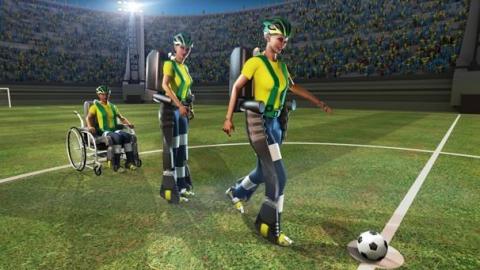Mind-Controlled Robotic Exoskeleton Kicks off World Cup

What’s the Latest?
Brazilian superstar Neymar may have scored the decisive goals during his squad’s victory over Croatia, but the most important kick of the day may not have come from human feet. A paraplegic man, aided by a special mind-controlled robotic exoskeleton fashioned by scientists at Duke University, performed the ceremonial kickoff opening the World Cup. Dr. Miguel Nicolelis, the lead neuroscientist on the project, had targeted the World Cup as the optimal occasion to introduce the new technology:
“I thought it was a way to show the World Cup can be more than just football and parties.”
What’s the Big Idea?
Popular Science has a thorough explanation of how the amazing exoskeleton works:
“The exoskeleton — a system comprising a helmet implanted with a microchip that sticks out from the underside; a T-shirt loaded with sensors; metal leg braces; and a battery worn in a backpack — is set in motion when the user envisions himself making the kick. The chip translates those electronic commands to a digital language that powers the skeleton, which then moves accordingly. The T-shirt vibrates to enhance the user’s sensation of movement (and eliminate the need to look at his feet to see if he’s stepping forward).”
Nicolelis states his goal is for formerly handicapped people to be walking through the streets in these devices within ten years. He even thinks that a victim of paralysis could use an exoskeleton to compete in the Olympics by 2034. Showing off the exoskeleton at the World Cup allows Nicolelis’ team to accomplish another one of its goals: to spread hope to the people of the world. And it would have, if the major television networks had televised it…
Read more at Popular Science
Photo credit: Walk Again Project





